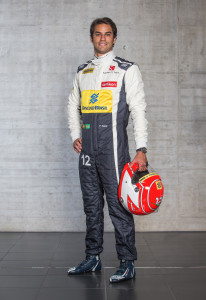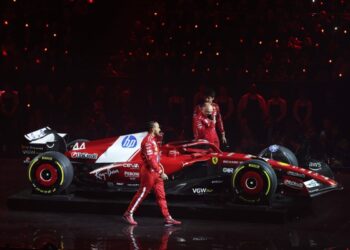On its media portal the Sauber F1 Team presents the new Sauber C34-Ferrari. With regard to the 2015 season, team principal Monisha Kaltenborn said: “2014 was a very disappointing year. However, this is in the past, and we now focus on what comes next. We have learned our lessons and are confident for the new season. We have to improve, and be able to fight for championship points.” For the Sauber F1 Team 2015 is its 23rd season in Formula One; it is the fourth oldest of the current brands.
 Monisha Kaltenborn is optimistic about the new driver line-up: “I am delighted about our two new drivers who bring a breath of fresh air. Both are young, talented and highly motivated. On their way to Formula 1 both stood out through victories in Formula BMW and Formula 3. Both then finished this career progression off in the GP2-Series. While Marcus looks back to one season in Formula 1, Felipe will have his rookie year in which he comes fully prepared due to his role as test and reserve driver at Williams last year. I feel confident with regard to our drivers.”
Monisha Kaltenborn is optimistic about the new driver line-up: “I am delighted about our two new drivers who bring a breath of fresh air. Both are young, talented and highly motivated. On their way to Formula 1 both stood out through victories in Formula BMW and Formula 3. Both then finished this career progression off in the GP2-Series. While Marcus looks back to one season in Formula 1, Felipe will have his rookie year in which he comes fully prepared due to his role as test and reserve driver at Williams last year. I feel confident with regard to our drivers.”
 Marcus Ericsson also looks into the future with optimism: “I am pleased about being a member of the Sauber F1 Team. After a difficult season, we want to move forward and fight in the mid-field like the team previously did. From a driver’s point of view, I want to continue to learn and establish myself as a Formula One driver. I have the feeling of being in the perfect environment to do so. In Formula One it is difficult to have precise targets, as it depends on the overall package. It is clear that we want to be fighting for points.”
Marcus Ericsson also looks into the future with optimism: “I am pleased about being a member of the Sauber F1 Team. After a difficult season, we want to move forward and fight in the mid-field like the team previously did. From a driver’s point of view, I want to continue to learn and establish myself as a Formula One driver. I have the feeling of being in the perfect environment to do so. In Formula One it is difficult to have precise targets, as it depends on the overall package. It is clear that we want to be fighting for points.”
 Felipe Nasr explains: “In my rookie season there is a lot to learn, and especially as I have not yet driven on some circuits yet. In general, I am ready to take on this challenge. In my role as test and reserve driver for Williams last year, I was involved in every race weekend. Furthermore, I also had the chance to drive the car a few times, so I think I have a certain understanding of Formula One. Now I am taking the next step in being a race driver, and I am looking forward to bringing my experience from 2014 as well as to supporting the Sauber F1 Team in getting back into the points.”
Felipe Nasr explains: “In my rookie season there is a lot to learn, and especially as I have not yet driven on some circuits yet. In general, I am ready to take on this challenge. In my role as test and reserve driver for Williams last year, I was involved in every race weekend. Furthermore, I also had the chance to drive the car a few times, so I think I have a certain understanding of Formula One. Now I am taking the next step in being a race driver, and I am looking forward to bringing my experience from 2014 as well as to supporting the Sauber F1 Team in getting back into the points.”
 Test and reserve driver is Raffaele Marciello who, as well as other series, won the 2013 Formula 3 Championship in an outstanding way. Last year he had two podium finishes and won the main GP 2 race in Spa-Francorchamps. Raffaele will also have the opportunity to participate in some Friday practice sessions during Grands Prix. Monisha Kaltenborn said: “Raffaele’s previous career is impressive. Therefore it is a logical step for us to give him the opportunity to become more familiar with Formula 1. As a team we are pleased to be there with him on his way to the pinnacle of motorsport.”
Test and reserve driver is Raffaele Marciello who, as well as other series, won the 2013 Formula 3 Championship in an outstanding way. Last year he had two podium finishes and won the main GP 2 race in Spa-Francorchamps. Raffaele will also have the opportunity to participate in some Friday practice sessions during Grands Prix. Monisha Kaltenborn said: “Raffaele’s previous career is impressive. Therefore it is a logical step for us to give him the opportunity to become more familiar with Formula 1. As a team we are pleased to be there with him on his way to the pinnacle of motorsport.”
Raffaele Marciello explained: “I am really pleased to be a member of the Sauber F1 Team, which has a long tradition of building up excellent drivers. I really think that this is the best choice for my future career. I am also happy to compete for one more season in the GP2 Series, which, together with my new F1 role, will give me a very busy 2015 season. I want to thank the people at the Ferrari Driver Academy who are responsible for giving me this important opportunity, and now I really can’t wait to start delivering my best.”
 Sauber C34-Ferrari
Sauber C34-Ferrari
After a season with the most comprehensive technical changes in the history of Formula One, there are significantly fewer regulation changes for the 2015 season. During the development of the new Sauber C34-Ferrari the Sauber F1 Team’s engineers focused on three areas: performance in slow corners, weight reduction, as well as braking stability.
Eric Gandelin, chief designer of the Sauber F1 Team, explained: “We were able to gain a lot of experience during the course of the 2014 season, which will have an influence on the Sauber C34.”
Aerodynamics traditionally play a key role in the development of a new car. But on this occasion it wasn’t only a question of optimising downforce and drag, but also improving the balance of the car and its responses in particular through low-speed corners. The greatest visual difference compared to the Sauber C33 can be found around the nose section, which is now bigger in volume and lower to the ground following further changes to the technical regulations. This has a considerable impact on the aerodynamics of the entire car: the nose and front wing play a key role in determining how the air flows around the front wheels and how effectively the central and rear sections of the car function aerodynamically. The new design of the wheel rims has progressed in a similar direction, in the interests of optimising airflow around the front wheels.
 The front suspension concept has changed little, with the springs and dampers again pushrod-actuated. However, the engineers put a lot of effort into improving the feedback from the steering for the drivers.
The front suspension concept has changed little, with the springs and dampers again pushrod-actuated. However, the engineers put a lot of effort into improving the feedback from the steering for the drivers.
The sidepods of the new Sauber C34, are now slimmer than those of the Sauber C33, despite higher cooling requirements from the new power unit. This has been made possible by modifications to the attachment of the side crash elements. In addition, the architecture of the radiators, which are now positioned horizontally, has been fundamentally revised. The engineers also paid great attention to the flexibility of the cooling system, which can be adapted precisely – and individually for the various components – to the ambient temperature and circuit characteristics. For example, small air vents on the side of the cockpit are only used in certain situations. Beyond this, the rear section as a whole is less voluminous, which benefits aerodynamic efficiency.
The car’s minimum weight has been increased in line with the FIA’s technical regulations, up from 691 kg a year ago to 702 kg now. The engineers, of course, set out to undercut this figure in order to give themselves ample room for manoeuvre when it comes to weight distribution – an important factor in determining how the car uses its tyres.
The car’s engine, energy recovery system and gearbox are again supplied by Ferrari. The 1.6-litre turbocharged V6 engine has a rev limit of 15,000 rpm. The technical regulations allow for certain components to be completely redesigned for the 2015 season. The aim has been not only to increase the power from the turbocharged engine, but above all to optimise the car’s energy recovery and energy storage capability.
In terms of its concept, the engine is very much comparable with last year’s, but its architecture has changed significantly, necessitating numerous adjustments to the chassis. The exhaust tailpipe is again positioned centrally between two pylons, though they are no longer supported by the rear crash element, but by the gearbox housing.
The spring and damper elements at the rear axle are again pullrod-actuated, but otherwise this is a totally new construction with separate lower wishbone legs. In addition, the engineers worked on improving the mechanical traction. Besides a number of other parts, there will be optimised gear ratios to support this effort. As with its predecessor, the packaging of the Sauber C34 presented the engineers with a genuine challenge. After all, in excess of 40 electronics boxes have to be accommodated, of which more than 30 require cooling.
 A first impression of the value of these measures will be obtained at the first test in Jerez. “Later on it will be crucial to see where we stand in comparison to our competition,” explained chief designer Eric Gandelin.
A first impression of the value of these measures will be obtained at the first test in Jerez. “Later on it will be crucial to see where we stand in comparison to our competition,” explained chief designer Eric Gandelin.
The Sauber F1 Team will use a roll-out version of the car for the first test at Jerez. Some components are still from the Sauber C33 and will be successively replaced by new parts. “We will use the time up to Melbourne to ensure we’re as competitive as possible when we line up on the grid for the season opener,” added Eric Gandelin.
Redazione MotoriNoLimits

























